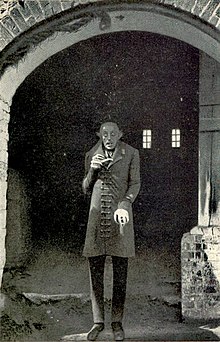
Back سينما ألمانية Arabic Almaniya kinosu Azerbaijani Германско кино Bulgarian Cinema d'Alemanya Catalan سینەمای ئەڵمانیا CKB Deutscher Film German Γερμανικός κινηματογράφος Greek Cine de Alemania Spanish سینمای آلمان Persian Cinéma allemand French
| Cinema of Germany | |
|---|---|
 Max Schreck as Count Orlok in the 1922 film Nosferatu. Critic and historian Kim Newman declared it as a film that set the template for the genre of horror film.[1] | |
| No. of screens | 4,803 (2017)[2] |
| • Per capita | 6.2 per 100,000 (2011)[3] |
| Main distributors | Warner (19.5%) Walt Disney (11.5%) Sony Pictures (11.1%)[4] |
| Produced feature films (2011)[5] | |
| Fictional | 128 (60.4%) |
| Animated | 5 (2.4%) |
| Documentary | 79 (37.3%) |
| Number of admissions (2017)[2] | |
| Total | 122,305,182 |
| • Per capita | 1.48 (2017) |
| National films | 28,300,000 (23.1%) |
| Gross box office (2017)[2] | |
| Total | €1.06 billion |
The film industry in Germany can be traced back to the late 19th century. German cinema made major technical and artistic contributions to early film, broadcasting and television technology. Babelsberg became a household synonym for the early 20th century film industry in Europe, similar to Hollywood later. Early German and German-speaking filmmakers and actors heavily contributed to early Hollywood.[6][7]
Germany witnessed major changes to its identity during the 20th and 21st century. Those changes determined the periodisation of national cinema into a succession of distinct eras and movements.[8]
- ^ Marriott, James; Newman, Kim (2018) [1st pub. 2006]. The Definitive Guide to Horror Movies. London: Carlton Books. p. 20. ISBN 978-1-78739-139-0.
- ^ a b c "Kinoergebnisse". www.ffa.de (in German). FFA Filmförderungsanstalt. Retrieved 15 September 2018.
- ^ "Table 8: Cinema Infrastructure – Capacity". UNESCO Institute for Statistics. Archived from the original on 24 December 2018. Retrieved 5 November 2013.
- ^ "Table 6: Share of Top 3 distributors (Excel)". UNESCO Institute for Statistics. Archived from the original on 24 December 2018. Retrieved 5 November 2013.
- ^ "Table 1: Feature Film Production – Genre/Method of Shooting". UNESCO Institute for Statistics. Archived from the original on 26 December 2018. Retrieved 5 November 2013.
- ^ "How German emigres defined Hollywood's golden age". 12 August 2022.
- ^ "Germans in Hollywood". The German Way. Retrieved 25 February 2024.
- ^ Pam Cook (2007). The Cinema Book. London: British Film Institute. p. 207. ISBN 978-1-84457-192-5.